Many overlanding friends warned us about the limitless trash piles along the Pan-American Highway paralleling the Peruvian coast. This is an area the usual tourist doesn’t venture to, for good reasons. In general, the North coast is desolate, depressing, stark, and filthy, but there are a few interesting sites to check out.
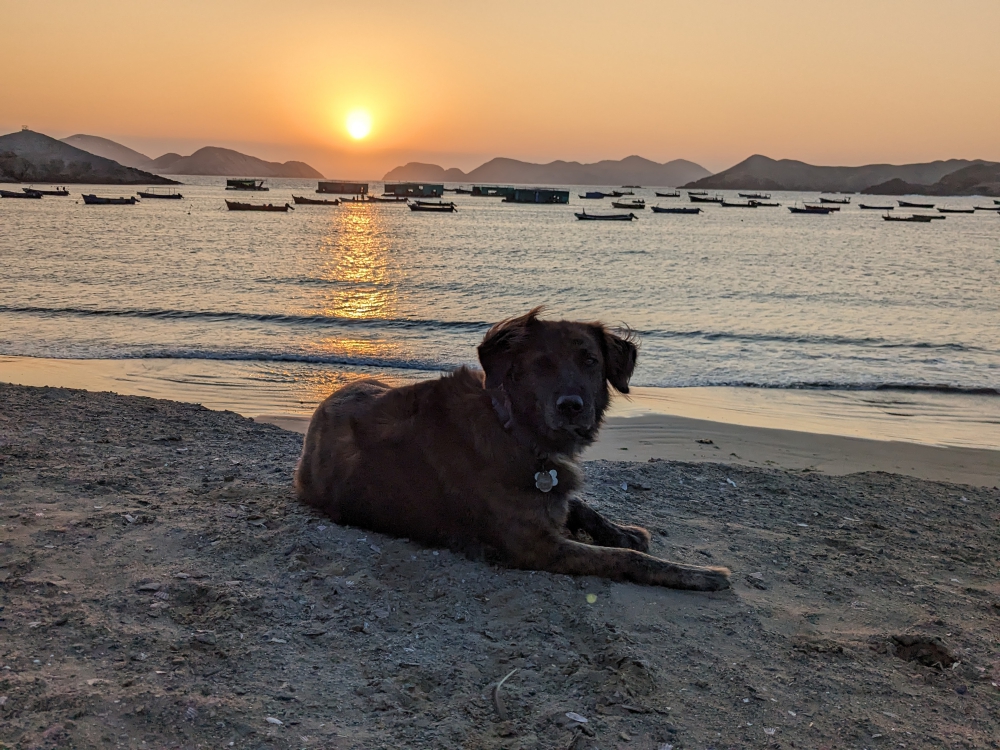
Sunset at the beach
Puerto Malabrigo
After leaving Cajamarca, Mark, Maya, and I continued our drive to the Peruvian coast, mainly because the road south from there (the Panamericana) is paved, smooth, wide, and fast. That part was a nice change from the narrow, curvy, sketchy roads we’d been taking to cross the Andes Mountains.
(As always, hover over or click on photos in galleries to read their captions.)
The scenery, however, was bleak and – as expected – heavily littered. Sometimes, it looked and smelled like we were driving through a garbage dump. Sad.
Our first stop was a free beach camping spot in Puerto Malabrigo, which we had picked based on the descriptions and photos in our trusty app iOverlander. There are not a lot of places where you can actually camp on the beach, and be surrounded by relative peace. The fact that this site had picnic tables and a thatched umbrella for shade was a bonus. We leveled up at the end of this area, so nobody would pass us, and were pleasantly surprised with this find.
Actually, we were super excited and relieved about the prospect of finally sitting still for a few days. The sand was soft, the beach long and flat for walks with Maya, the internet worked well, our cabinets, fridge, and water tanks were full, a newly built boardwalk beckoned, we could hear the waves, and the small town offered tiendas (stores), restaurantes, and panaderias (bakeries).
Our joy was short lived.
From the moment we settled into our chairs next to the camper with a drink around 5pm, locals started shooting off homemade explosives, which disturbed the peace and had Maya worked up. It was Friday… At intervals, the noise continued until 3am and then started again at 6am and throughout the day on Saturday.
From early morning, tuk tuks drove inches from our camper, despite us being parked at the end of a beach road. When we put our mat and chairs on the narrow stretch next to us, they would honk, until we folded the mat back and let them pass. Stopping before our camper seemed out of the question. Peruvians are a people of habits. And honking for everything is common practice.
We had looked forward to beach walks with Maya, but she was out of sorts, tail between her legs. In the afternoon, we managed to quickly take her away from the village and towards a remote bay, where she lightened up a bit. We spotted a seal (and were appalled by how close a local family got to it – pure harassment), cool cliffs, and brave surfers, before returning and moving our camper before dusk, further away from the town and booms. We still heard them there as well.
Because of the sporadic, loud fireworks (they even made our hearts jump), we decided to leave the area already on Sunday, expecting another day of it. Maybe this place is better visited and enjoyed during the week? We will never know.
El Brujo Complex
Craving peace, we headed to a small pyramid, Huaca Cortada, that is part of the El Brujo ruins. The surroundings were eerie, desolate, and barren, but… quiet! The small parking lot was flat and when the wind dropped, sand stopped entering through the screens. We spent one night here.
Ironically, as the sun set over the water, two guys showed up in a pickup truck and shot firearms into the ocean. Tradition? Practice? Fun? It was short lived and done responsibly; I don’t even think Maya heard anything. The unexcavated pyramid was interesting and we slept well, but leaving behind the two small stray dogs that hung around our camper the entire time broke our hearts. At least they had full bellies for one evening.
The following morning, we visited the main part of El Brujo: Huaca Cao Viejo (Old Cao Temple) and Museo Cao, famous for its mummy, “The Lady of Cao.” The ruins of the temple were fascinating and the complex was professionally run, restored, organized, and informative, with signs in Spanish and English as well as an excellent, free audio tour. Mark and I both felt like we learned a lot about the Moche culture. Maya stayed in the shady camper.
The museum enlightened us further with facts, drawings, pottery that reminded us of our friend Alison Palmer’s work (when sending her photos, she told us her inspiration came from the Moche, even though she never visited Peru), and the main artifact, the mummy of Cao, which cannot be photographed. A replica was provided for that purpose.
I was all about staying for the night at this safe, flat, and quiet parking lot and even arranged this with the guard (usually it isn’t allowed), but Mark wanted to keep moving, because the area wasn’t “anything special.” Being able to sleep at night is special, no?
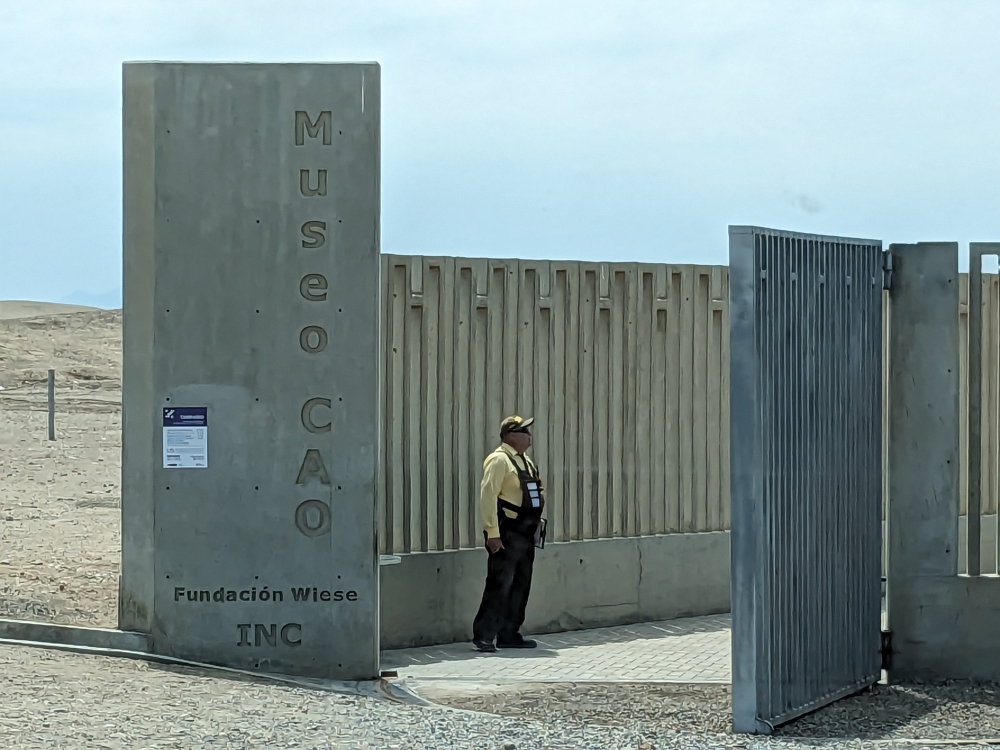
Friendly guard at the museum
Huanchaco
From the moment we arrived in Huanchaco, raved about by Lonely Planet and local visitors, we disliked the place. It was busy, touristy, ugly, and expensive. At least it was Monday and no bangs should sound. We pulled up along the sidewalk at the northern most end of town, far away from any activity. Then, we went for a stroll on the long promenade, which was fairly pleasant. The traditional reed boats of the fishermen are the main attraction here.
Traffic kept passing by late at night, inches from our camper, boomboxes sounded from the beach, and at 2:30am, a group of people pulled up directly in front of us. They opened their car doors, blasted music, and the girls sang along outside. Seriously? There was so much space elsewhere…
We “tolerated” the noise and dozed on and off until 4:30am, when I put my clothes on and marched towards the car. The three girls saw me come, giggled, quickly jumped inside, and locked the doors. It was comical. I addressed them sternly but politely, and soon after, they pulled out.
We should have stayed by the museum, but there was no cell service, just like at the small pyramid. Being without internet for two days is pushing it for us, regarding work and staying in touch with (elderly) family. After another sleepless night, Mark told me I could pick our camping spots for the next six nights. 😊
Trujillo
Our next stop was Trujillo. I had read about its attractive historic center, but Mark didn’t have much interest in stopping. My choice, so we picked a decent free spot (clean, safe, level, guarded) by a park for the day and night. Not bad!
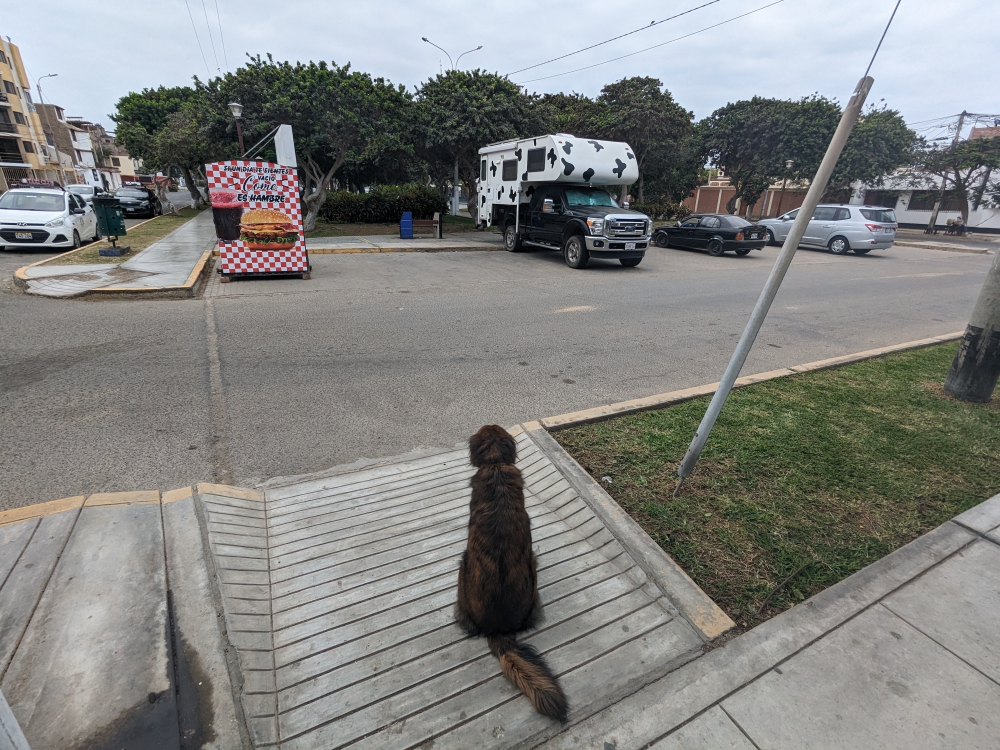
The food stand next to Thirsty Bella remained open, attracting (loud) customers, all night!
We dropped off our laundry and walked Maya to the center of town. From the moment we arrived and ventured around, we could feel a difference with everywhere else we had stopped in Peru. People were friendly, the sidewalks were clean, we passed an American school and Peruvian university, greenery was part of the landscape, the stores and restaurants looked modern and inviting, and we were smiled at!
The main square, surrounded by colorful buildings, was big, clean, and green. The police force was smartly dressed and we enjoyed sitting on a bench and watching the scene, just like we’d often done in Colombia and Ecuador. This was nice!
Mark and I took turns visiting a free museum along the plaza and then, we all strolled back home. To our surprise, vendors started popping up mid-afternoon, and the security guard asked us to move. We were parked in the exact location of one vendor, who could not possibly move over one or two parking spots. Habits…
We abruptly stopped work and moved a block. Unbeknownst to us yet, we then parked next to the only food stand that would stay open all night long… Nevertheless, we chatted with a handful of friendly and curious residents, had a local dinner out (Mark tried their specialty of anticuchos: beef hearts and gizzards) without Maya (who disapproved by nibbling on a roll of toilet paper), and picked up our three loads of fresh laundry.
After a startling, noisy, and sleepless night, we drove to highly regarded and recommended ruins the following morning: Huacas del Sol y la Luna, located about half an hour south of Trujillo. Unfortunately, we had to wait for an hour for the next tour. The place was packed with hundreds of school children!
The ticket price for this archeological site includes a guide, either Spanish or English speaking. Ours was fair; we felt we learned more about the Moche (pre-Inca) culture at El Brujo than here. That being said, the preserved parts of the pyramid, especially the reliefs and paintings were incredible.
Archeologists here only unveil and expose; they don’t restore. Right now, the Moon Temple and the old town are being excavated. The Sun Temple remains untouched. As money comes in, more sites, remains, and treasures will be unearthed and researched. If not looted yet by grave robbers.
Tortugas
Friends had told us about the sleepy fishing village of Tortugas and the reports in iOverlander sounded promising as well for a few days of highly needed peace. From the ruins, we pushed to get there the same afternoon, before dark. Our first night was spent on a pull-out of a supposedly quiet road.
From the moment we were settled, the sun went down over picturesque rocks and a couple of men – guards from the abutting shellfish plant – checked in on us. They suggested we’d move to the beach further down, but it was too late in the day and we were too tired to pick up our home again.
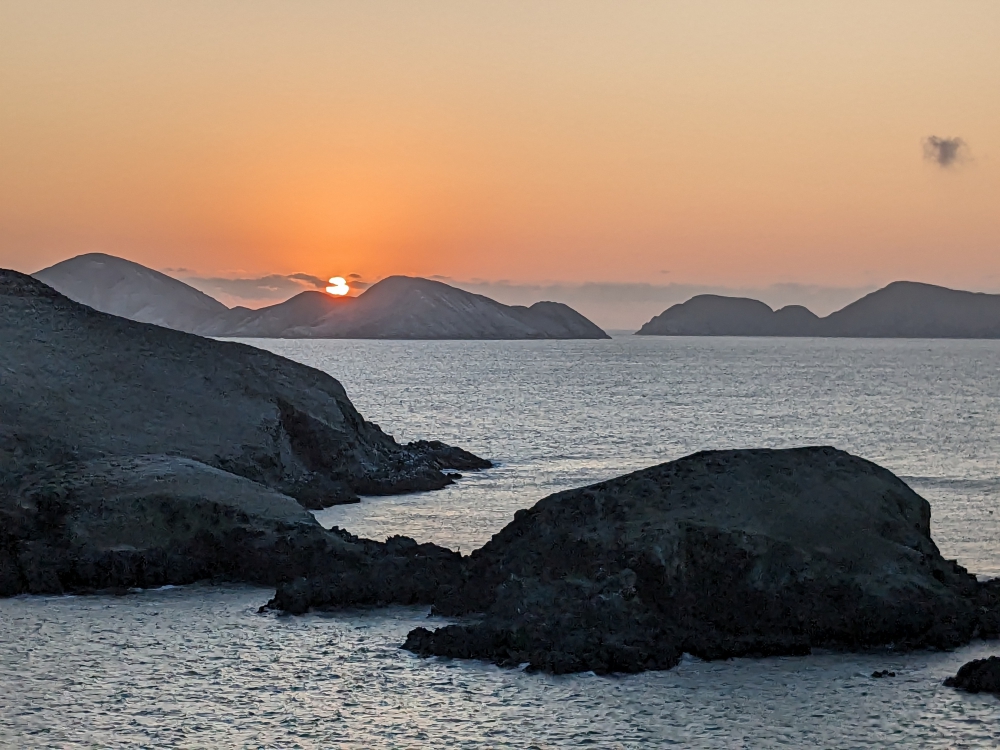
Beautiful view and sunset
Starting at 4am, trucks and busloads of workers passed by super close and we didn’t sleep anymore. The following morning, we walked Maya around a bit more to survey the neighborhood.
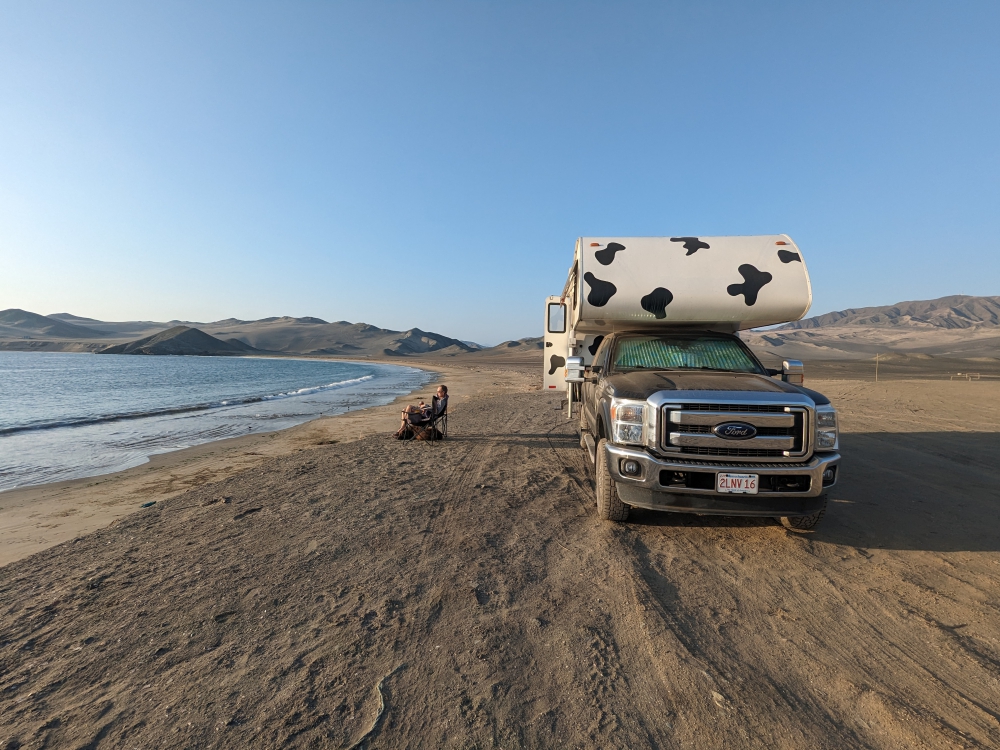
Home for a few undisturbed days
After breakfast, we settled at a “dirt patch” next to a wide, open, quiet beach. On one side, we spotted the massive shellfish plant (which sometimes omitted a smell of rotten fish) and on the other side of us was nothingness in the form of brown, hilly, and barren scenery. Perfect!
Since I was in charge of our nights, we spent a few relatively quiet ones here, next to a cell tower, giving us the chance to catch up on work, rest, writing, and beach walks with Maya.
One day, we made the six-mile trek into town and back, feeling as if we were walking in a desert. The fishing village was bigger than we expected, but it meant there were trash cans, tiny stores, and restaurants. We recharged with a glass of freshly squeezed orange juice, before the walk back.
Our last night in the area was spent along the town’s bay, since we had run out of potable water (available in 5-gallon jugs here) and craved a ceviche dinner. The wind had picked up again, so sand was blown all over us, making it inside through the screens. Gritty times.
In Tortugas, we also discovered a new reason for waking up in the middle of the night. Twice. A bunch of cats had made it into the bed of our truck (in a void under the camper), decided to fight out a battle, screaming like only cats do, and peeing while they were at it. The commotion freaked Maya out and had her jump into the bed with us again. Just like she does when there are boomies…
After all that, we temporarily left the coast behind and returned to the Andes Mountains in search of solitude and beauty. Spoiler alert: we found it!
Curious about a previous ten-year chapter in our nomadic lives, which includes eight years aboard a 35-foot sailboat in the tropics with dogs, check out my compelling, inspiring, and refreshingly honest travel memoir:





































































































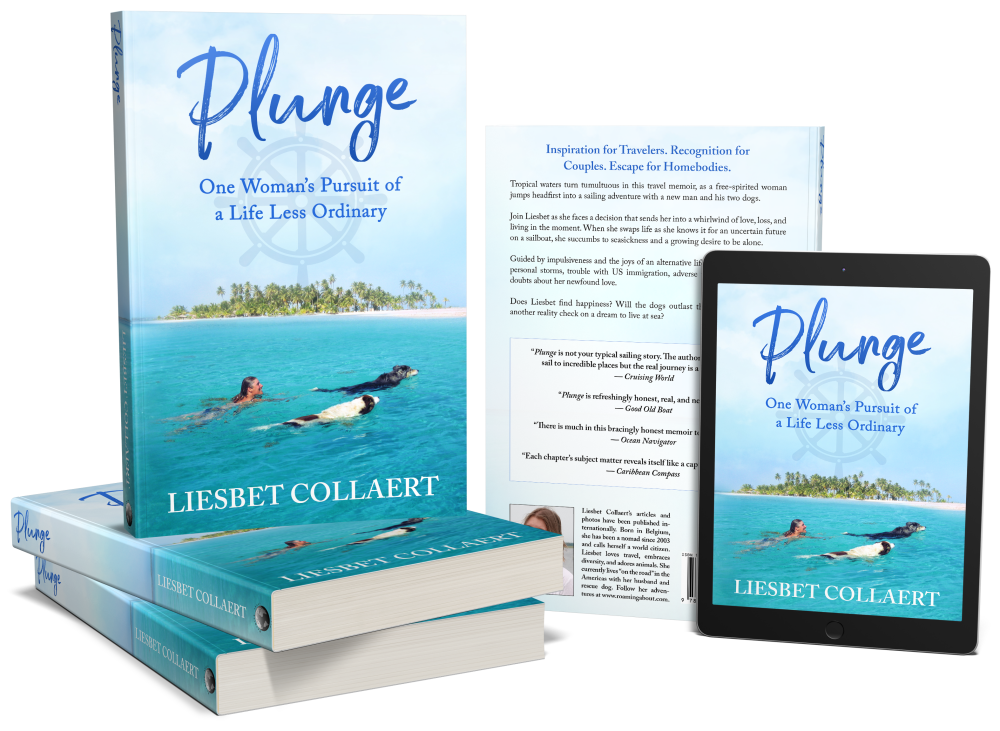




September 10, 2023 at 22:23
I know you kind of have to (or, ideally, want to) work your way through a country in your camper, but can you just hightail it out of a whole region if you are finding it regularly miserable? It seems like northern Peru has been really frustrating for you guys, and I’m wondering if I might not just get out of Dodge and move on if I were in your shoes?! Do you hold out hope for one small gem, or is it just about slowly making your way and dealing with all the unpleasant stuff along the route?
September 12, 2023 at 10:41
Hi Lexie,
That’s a good point. The thing is that Peru is huge and driving is much more taxing than in western countries, so we have to stop after maximum 6-8 hours on the road. Even by just camping one night in between stops, it would take us about two or three weeks to get to a more pleasant area. So, we try to time those stops at or near interesting ruins or towns.
The other issue is the high cost for gas. We like to spread out those expenses, even though at the end of the year, it doesn’t make much difference – we have to drive those distances no matter what. But sitting still for a few days at a time, gives us a break from the crazy drivers and from filling up with gas again.
So, while we prefer to slow travel, we do actually feel that we somewhat hightailed it through Northern Peru, haha. Apart from our multiple-day stop at Tortugas, because we really needed a break and felt it was quieter than other places.
Another consideration is work. We do have to put in a certain amount of hours every week and that’s only possible when we find a place to sit for a few days, where cell service works adequately and some sleep is available.
We have no issue skipping entire parts of countries when nothing works out or feels right. It’s the other factors that define our pace.
September 12, 2023 at 21:27
Thanks for explaining! I totally get it now. Hope you are into better areas soon!
September 14, 2023 at 12:52
Hi Lexie,
It’s getting better the more south we drive. Just like other overlanders promised us! 🙂
September 11, 2023 at 02:45
Oh my word. It seems trash and noise on beaches are universal scourges, although we’ve not had to endure firearms in the Balkans.
I feel for you and am so glad you find peace in the Andes!
September 12, 2023 at 10:46
Hi Jackie,
As you know, no place is perfect. I think we’d all settle down there one day, if it existed.
Peru has caused us a lot of struggles and discomfort, but nothing too bad. Except for the incapable, selfish, and crazy drivers. I’d say that, by far, is the worst and most stressful part of being here. I can’t even describe what we experience and feel when driving through a city. Fear! Something I rarely encounter. It’s insane.
And, yes, beaches worldwide seem to attract a younger crowd that likes to drink, party, and play loud music. Mark and I finally found a quieter beach yesterday – again, we were pleasantly surprised and hopeful. All was well until I wanted to go to bed at 10pm (utterly exhausted again) and a car showed up with laughing, screaming, music-blasting people, right next to us. I feared the worst, but they left after half an hour and we enjoyed a peaceful night after that. It. Was. So. Nice. 🙂
September 12, 2023 at 13:05
Speaking of fear…
I heard a relevant quote the other day.
“Fear is the price of Freedom”.
The problems – such as screaming kids & throbbing generators- that I increasingly encounter while dry camping in public campgrounds during my summer travels pale by comparison with what you guys are enduring…
September 12, 2023 at 13:27
I should add that a key difference is that I’m paying for my campsite.
When you pay for a campsite you have the right to expect some peace and quiet!
September 12, 2023 at 13:49
I agree, John!! If we were to pay for our campsites, we would be more upset than when boondocking for free. Is there nobody to complain to?
For us, staying at paid camping areas might help at times, but it’s not a guarantee. The Latin American culture is loud; the sounds of fireworks, music, barking dogs, screaming roosters, and construction work cross campground borders and invade thin camper walls.
By the way, here’s a little new development that might interest you: we bought and have Starlink now. 🙂
September 12, 2023 at 15:22
I have commented to many folks regarding your travels that you guys are way more courageous than I am! But I guess that begs the question – are some people born courageous or did they learn to be that way? Either way it’s an admirable trait!
Starlink! WooHoo! Now you have the bandwidth to suffer the task of reviewing my 2023 summer travels photo album, lucky you:-) Hope you like flowers…
https://photos.app.goo.gl/V7z7QKrMkw5M8FR79
A peaceful Pacific atoll sounds pretty good. But that reminds me of some of the other costs of freedom. For example the sacrifices in comfort and convenience. Long swim to the nearest grocery store, laundromat, fresh water, etc:-)
September 14, 2023 at 12:47
Hi John,
To answer your question: it’s probably a mix. We might have gotten some courage in our genes by birth and then – based on our education, upbringing, companions, living conditions, and experiences – we might become more fearful or less fearful, more courageous or less courageous as we age. 🙂
Can’t wait to check out your photo album. Yes, we have the internet (although, wouldn’t you guess that we are caught in Peru’s second-biggest sandstorm in history right now, meaning that Starlink actually didn’t work for two days because the satellites were “blocked” by all the sand in the air!?), now I only need a bit of extra time.
You hit the nail on the head there. To me, the biggest cost of freedom (in our situation) is the lack of comfort and convenience! But, what’s life worth without a healthy dose of challenges? We have to keep it all exciting.
September 12, 2023 at 13:45
Hi John,
While I don’t like the sound of that quote “Fear is the price of freedom,” it does ring through in many ways. I’m not a fearful person at all. If I was, or if we were, we’d never leave the comfort of a conventional home or country.
But the drivers in Peru would impact everyone with nerves of steel. Even as a passenger, I’m super stressed, so I can imagine how Mark feels. I asked him yesterday, driving through Lima, and he was extremely stressed and worried about someone driving into us. First country that has happened.
Anyway, it is a shame that peace and quiet are so hard to find!! Anywhere. Except on the water in a remote atoll. Maybe we should go sailing again? 🙂
September 11, 2023 at 08:40
Sad there is just so much noise. And garbage. I’m with you – sleep is very interesting!
September 12, 2023 at 10:47
I think sleep is underrated in the western world. And, comfort and convenience! 🙂
September 11, 2023 at 09:06
Wow! It makes you wonder why is the Peruvian coast is so badly cared for. How sad your stay on the Puerto Malabrigo beach was so short lived. This idea of fireworks seems to be a reoccurring theme down south. I had to look up what a tuk tuk was, I learn something new every day. I don’t understand why they drove so close to you when there was a beach in front of you and available to them? Your experience with stray dogs is what keeps us from going south. We are afraid we will return to the states with a dozen dogs with us. How sad Huanchaco turned out a bummer. Your confrontation with the girls must have been a ‘last straw’ since it could have turned bad fast. Trujillo must have been a wonderful temporary respite, except for another sleepless nights sleep. Glad to hear you got some rest and sleep in Tortugas, after one bad night there… well except for the cats! Sounds like the next blog post about going back into the mountains will share some better sleeping conditions. Stay safe you three. Jim
September 12, 2023 at 10:56
Hi Jim,
Thank you for your thoughtful comment. I don’t know how you remember all the things you read and then manage to create a detailed and well-considered comment. When I read your posts, I have all these reactions in my head, but when I get to the end and am ready to write a comment, I’ve forgotten half of them!
Yesterday, we drove along the coast south of Lima and stared at the vast, blue expanse of ocean, thinking exactly the same. The coastline is so long with so much potential! Then, our eyes wandered back to the road and its immediate surroundings – bleak, grey, dirty, uninspiring. Crumbling buildings. Empty lots. Failed housing developments. Garbage. No idea why this can’t be turned into something more attractive.
Tuk tuks come in different forms. I was mostly aware of them in Asia, where the tuk tuks are motorized and the rickshaws leg driven. They have different kinds of tuk tuks here as well. Some longer, less enclosed ones are called motoconchos.
Acknowledging and caring about the stray dogs – dead and alive – without being able to do anything about them has been the worst part of this journey for me. Heartbreaking. I don’t know what the solution is.
The fact that each night there was something else preventing us from sleeping became almost comical. I actually started to make a list of everything that has kept us awake over the last months. It’s extensive and impressive. And somewhat hilarious. 🙂
September 11, 2023 at 10:07
I was surprised by the flood of humanity, busi-ness, and people. Love your constant inclusion of Maya as family.
September 12, 2023 at 10:58
Hi Jacqui,
Maya is a huge part of the family and most decisions revolve around her. She is one lucky gal to have been adopted and brought on this amazing journey, with news sniffs, fellow pups, and different walks every single day! 🙂 Especially compared to the less fortunate strays around us.
September 11, 2023 at 16:01
Good grief! This doesn’t sound enjoyable at all – more like some horrible experiment as to how long you can keep your sanity while constantly sleep-deprived and stressed. You’re very tolerant and adaptable! If I were in your place, I’d have scurried back to North America with my tail between my legs weeks ago. 🙂
September 12, 2023 at 11:04
I hear you Diane! We are coming close to travel exhaustion again, after only one year in South America. The last (and only time) we experienced this was after eight years on a sailboat, a lifestyle that also came with a lot of stress, challenges, and sleepless nights. But we lasted eight years…
That’s why it’s so important for us to find quiet places to camp once in a while to rest up and charge those batteries. Being this tired and drained all the time takes its toll on our moods, energy, relationship, and other activities. 🙁
But, giving up is not our style – it will get better! – returning to the US entails a whole bunch of logistics and money. If the need arises, we will take a longer break and rent an apartment for a while, or return to Belgium or the US for a few months.
We are familiar with the ups and downs of exploring new parts of the world and usually the rewards are greater than the sacrifices. 🙂
September 11, 2023 at 18:23
I was so hopeful for you guys with that beautiful spot on the beach, but alas… damned fireworks again. What a scourge. I really don’t know how you operate when so sleep deprived all the time. I would lose my mind. I’m happy to see it looks like you found peace at your next spot though. Onward!
September 12, 2023 at 11:10
Hi Laura,
When reading our accounts in South America, you must be so happy to be comfortably settled in Portugal, haha. I have to admit that I’m starting to crave a comfy couch and less stress and discomfort. The hope is to rent a place for a month later this year. Maybe in Cuzco. But I’m sure we can even fill that up with work, chores, difficulties, and stress.
The sleep deprivation is weighing on us. Not only does it affect a lot of our decisions and moods, but it could lead to accidents when we drive. Peru has the worst drivers in the world (after India apparently) and I wouldn’t be surprised that we get in another accident here, even when Mark is wide awake and not tired…
So, yeah, it’s important we find a place that offers a good night’s rest once in a while. But you just never know… Despite positive comments in our app, anything can happen. And, a paid campground is not always the solution either. Friends of ours had to leave one of those recently at 1am, when loud music prevented them to sleep.
It is quieter in the mountains, at 12,000ft, but, as you can imagine, that brings other negative factors (cold, condensation, shortness of breath)…
September 12, 2023 at 13:05
Did Mark like the hearts and gizzard? Where is the map you have been including in other posts? I like seeing where places are.
Malabrigo? Bad coat? Sick coat? Curious name.
Some places are just so easy to travel in. Like the US – there are so many places to go and so many different types of travel. Or like sailing in the Bahamas – it’s just so easy. But it seems like South America is a bigger challenge. It is something new all the time, a new situation to work through or to learn about. I imagine it is exhausting- on top of the lack of sleep.
I love all the ruins. And those boats are super cool.
September 12, 2023 at 14:06
Hi Duwan,
I tried a bite of Mark’s two skewers as well and we both agree that the heart was not bad, but the gizzards were gross, sinewy with a crackling sound in your mouth. No, thank you!
Good point about the map. Since writing about Peru, I have been forgetting to create one! Thanks for reminding me. I’ll try to remember for the next post. My head is everywhere these days.
Someone told me that Malabrigo means “bad shelter” or “bad protection” which is possible, based on the wide open bay and amounts of wind.
You are so right about overlanding in South America being a different beast… As I’m writing this, we are facing yet another battle.
A crazy dust storm is enveloping us and the sand is getting everywhere. Of course, we can’t leave the windows shut as it’s 80 degrees outside. And, Mark is trying to work. It’s getting so dark because of the dirt in the sky that our internet dish barely works. The satellites are blocked and the dish is taking on gritty sand. We had to take it in and get on cell service again, if it keeps working. You can’t make this shit up, I tell ya.
Now I need another list: things that interrupt us when working. This sandstorm is the number two today. Number one was some crazy Peruvians pulling boats out of the water with two trucks hooked up to two trailers with straps in between. They spun so out of control on the beach that there was a good chance they’d hit us. So, we moved….
September 12, 2023 at 17:31
This sounds like a nightmare trip with a few moments of relief. The only positive thing is that the stray dogs have a buffet of garbage to sniff through for meals. Thanks for the Peruvian tour!
September 14, 2023 at 12:50
Hi Nancy!
Yes, I have come to the same conclusion that the garbage at least provides some food to the innumerable and hungry stray dogs.
For weeks, we have been wondering what the big fuss about Peru is by everyone who visits here. I think because of the way we travel, we get to see it all. Not just the tourist highlights.
September 12, 2023 at 19:51
Well I for one am glad you got out of Dodge. Not thinking Peru was the place for your guys. I hope the Andes treats you kinder. And I hope you get some sleep. 🙂 <3
September 14, 2023 at 12:51
Haha. Thanks, Debby. We are not quite yet out of Peru or done with it (it’s a huge country and we still have to reach its highlights), but the Andes Mountains were more attractive than anywhere else in this country! Stay tuned for some amazing photos. 🙂
September 13, 2023 at 13:24
Hi, Liesbet, Mark and Maya – Your resilience is incredible – as are your patience and sense of adventure. I was relieved with the last line and greatly look forward to learning more about the solitude and beauty of the Andes Mountains.
September 14, 2023 at 12:54
Hi Donna,
I’ve been thinking about you and Richard and the unfortunate turn of events. Sigh! I urgently have to put that blog post about the Cordillera Blanca in Peru together. So little time to sit behind my computer for things like blogging! Soon… 🙂
September 14, 2023 at 07:57
What is it with South Americans and fireworks? The rubbish by the sides of the road is appalling, making what could be a beautiful coastal road something of beauty. I feel sorry for Maya (because of all the fireworks, and now screaming cats) and you when your sleep gets disrupted. But glad you found some amazing places that I’d never have known about if not for your blog, Liesbet.
September 14, 2023 at 12:57
Hi Hugh,
Every day without booms or blasting music from cars is a good day! Right now, back at the coast in Peru, we have been delighted about the lack of fireworks. But we still have people park close to us, listening to loud music, at least once a day. Luckily, it’s tolerable and we have been able to sleep most of the night! 🙂
I appreciate your continued interest and interactions on my blog and I hope you will like the photos of the Andes Mountain range in Peru, whenever I manage to post them!
September 14, 2023 at 21:01
Hi Liesbet, I hope you find nice and quieter places for your remaining time in Peru. The trash wasn’t something I saw when I visited Peru several years ago. I thought Peru had so many stray dogs until I arrived in Chile. Safe travels!
September 18, 2023 at 21:15
Hi Natalie,
I feel like we live among the Peruvians when we camp, say near a beach, and therefore, we see firsthand how they litter, party, and behave. Sometimes, I just want to hide in a quiet hotel room somewhere! 🙂
Oh no about the stray dogs in Chile. You confirm what other overland travelers have told us, that the stray dog problem gets worse as we head further south on the continent.